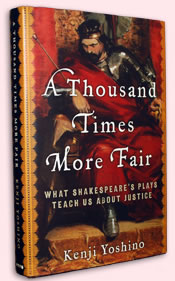A Lawyer's Bard Exam
 A Thousand Times More Fair: What Shakespeare's Plays Teach Us about Justice
A Thousand Times More Fair: What Shakespeare's Plays Teach Us about Justice
Kenji Yoshino (HarperCollins, 2011)
In the penultimate paragraph of his book A Thousand Times More Fair, legal scholar Kenji Yoshino proposes that Shakespeare's great purpose in the 21st century world is to draw us toward justice. “While much of what passes for art these days is pabulum, the same could be said of what passes for justice,” he writes. “The aspiration of this book is to transcend the hurly-burly of our daily politics to find a deeper register.”
With that as his calling, Yoshino offers up a clever, surprisingly easy-reading tome (this is a lawyer, after all) using Shakespeare's plays as both starting points and answers to the everlasting conundrum of what constitutes justice. His title comes from The Merchant of Venice when Portia tells Bassanio she wishes she could be “a thousand times more fair.” Yoshino points to the two meanings of fair, “just” and “beautiful,” suggesting not only an inter-relationship between the two ideals but that Shakespeare's presentations are themselves fair.
Not that he is a fan of Portia herself: he considers her Shakespeare's craftiest lawyer conniving her way through three trials, advancing her own self-interests by rhetorically tricking, in order, her father (the trial of the chests), Shylock (the trial of the bond), and Bassanio (the trial of the ring). Her ability to parse words in legal settings is exactly what President Bill Clinton did in the Monica Lewinsky scandal, Yoshino writes.
Current comparisons to various plots and characters in Shakespeare's plays is one of the delights of this book as Yoshino explores the many aspects of “justice”—legal, civil, social, legislative, natural, and personal. Titus Andronicus, in which a revenge vendetta overrides a weak state's system of justice, Yoshino likens to a similarly weak system of justice in a fledgling global society that led to the wars in Afghanistan and Iraq (yes, he compares President George W. Bush with Titus the avenger seeking family honor, and also Henry V as the prodigal son who turns his common-man persona into powerful politics that enable foreign adventuring). Measure for Measure explores three different approaches to legislative justice, and Yoshino applies Shakespeare's lesson to the confirmation process for Supreme Court Justice Sonia Sotomayor. Othello, of course, tracks with the O.J. Simpson trial, but not because of the main characters' race; rather, it is the role of “ocular proof bias” among the jurors deciding guilt or innocence in either case: Desdemona's handkerchief and O.J.'s glove.
Calling Macbeth a study in natural justice, Yoshino considers it Shakespeare's most comforting play because true justice prevails in the end and the wicked are punished. The fun part of this chapter is seeing the trial lawyer come out in the author, attacking the play's legendary status as cursed as if he were giving a closing argument taking apart the prosecution's case. Then he goes on to attack the whole premise of “natural justice” itself as falsely comforting. “I do not wish to play the spoilsport,” he writes. “Little harm is done by a belief in the Macbeth curse. But great harm is done by subscribing to the belief in the natural justice that undergirds both the play and the curse. Natural justice is a form of justice that occurs only in art. When we blur the line between art and life, the consequences for justice can be disastrous.”
By revealing Shakespeare's depiction of legal issues, A Thousand Times More Fair is an excellent law primer for the layperson, whether the reader is a fan of the plays or not. The prose is smooth and accessible, and the analysis leads to quite a few “ah-ha!” moments for the reader.
The book does have some head-scratching moments, too. Yoshino not only seems to have explored ideas that come out of left field, he sometimes goes out to left field to pluck the grass. He considers King Lear's love test not only justified but justly rendered, decrying those who would play the scene with a psychological reading rather than a political one; but it is Lear's psychosis more than his political judgment that leads to the great tragedy.
Furthermore, though he references productions of the plays, Yoshino makes the scholar's typical mistake of treating the plays as works of literature instead of scripts for the stage. For example, after citing how Othello, upon discovering his fatal mistake, says “O! O! O!” and falls on the bed, Yoshino expends considerable ink on how “‘O' is the letter in Shakespeare most pregnant in meaning, standing variously for the world, the crown, female genitalia, nothingness, and the theater.” That's all deeply interesting, but on stage ‘O' is just a character moaning or wailing in deepest despair. Yoshino also falls into a trap of seeing Prospero as a personification of Shakespeare's ideals, if not the playwright himself. The legal scholar gives way to sentiment to find suspect allegories in the play's lines and, Portia-like, he rhetorically twists Shakespeare's verse to arrive at his desired verdict.
I think he loses his case with The Tempest, though he makes a noble effort to show how “The Tempest teaches us to remember and celebrate the possibility that sometimes power does not corrupt, and to ask who our Prosperos are today.” But otherwise and overall, A Thousand Times More Fair is a winner.
Eric Minton
June 10, 2011
Comment: e-mail editorial@shakespeareances.com
Start a discussion in the Bardroom



 Find additional Shakespeareances
Find additional Shakespeareances